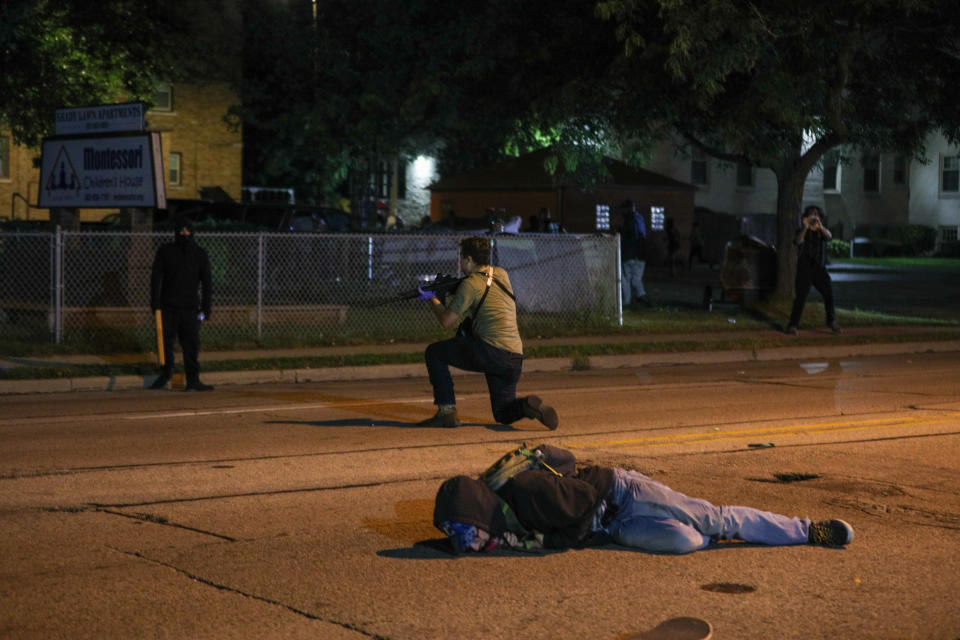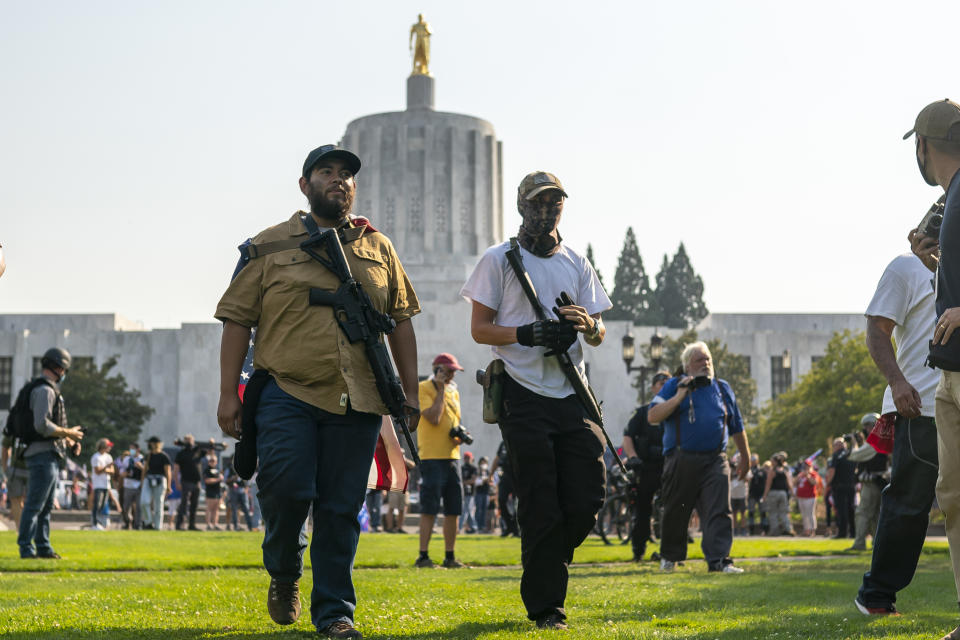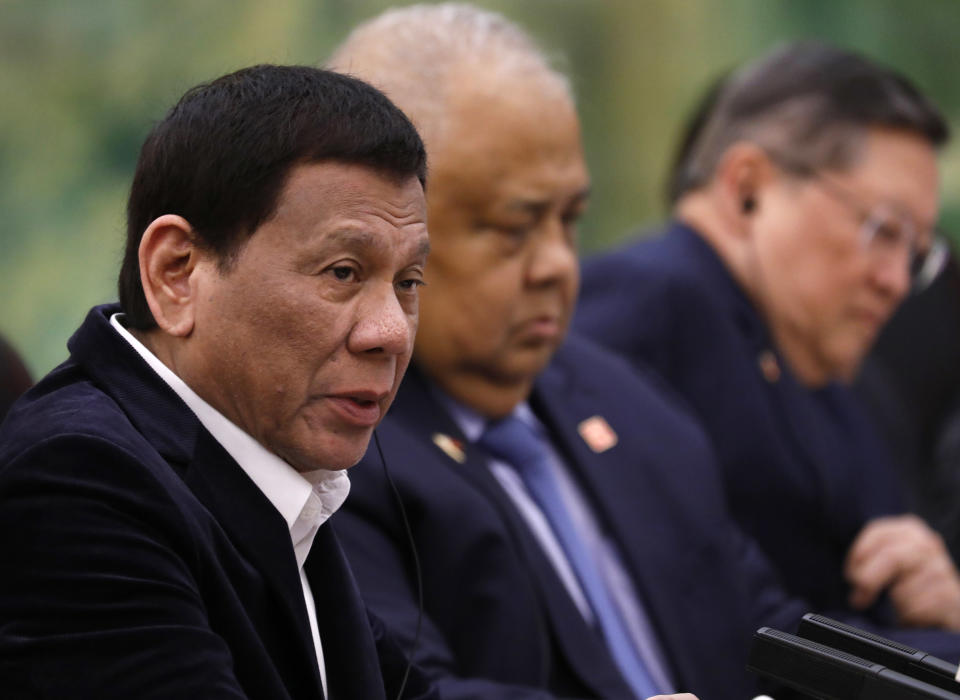What Portland and Kenosha say about the return of political violence in America
PORTLAND, Ore. — Political violence is easy to start, and nearly impossible to stop. A single incident isn’t enough to launch a cycle of democratic decay, although the recent killings in Kenosha (rightist shoots leftists) and Portland (leftist shoots rightist) should have everyone in America concerned.
With Election Day approaching, we are facing the possibility of months of politicized street violence, unprecedented in our lifetime, and an eruption of false symmetries and polarized thinking that amplify individual incidents into narratives of victimhood.
I’ve seen this before. As a correspondent in South America, Africa and the Middle East for two decades, I’ve watched democracy wrestle with violence and often lose.

In other countries, street fighting and assassinations have been prime drivers in a wave of recent authoritarian transformations. While there are risks to politicians who embrace one side of this divide — as President Trump has done, from Charlottesville to Kenosha — there is also a proven route to power through encouraging politicized violence.
Politicians from Venezuela to Turkey benefit from threatening their opponents, or having supporters do it. In Argentina, political parties routinely mobilize their members for violent street brawling before elections or even when trying to pass a bill. In the Philippines, President Rodrigo Duterte has actually cemented his popularity and power by encouraging a wave of vigilante killings.
The risk to democracy feels palpable here in Portland. In June, long-simmering Black Lives Matter protests against police brutality erupted in nightly violence as federal riot troops using tear gas and nonlethal munitions tried to clear the streets in front of the federal courthouse. Instead, thousands of new faces joined the protests in July, until Trump pulled back his task force.
A relative calm followed — late last month, I found the courthouse protest camp abandoned, the streets around it empty. Small, scattered marches continued around the city, often accompanied by property damage, trash fires and vandalism, including to the lobby of Mayor Ted Wheeler’s apartment building.
But by late August the nation’s attention switched to Kenosha, Wis., where a protest against a police shooting drew armed counterprotesters, and 17-year-old Kyle Rittenhouse allegedly shot three people, killing two.
The national and even global spotlight returned to Oregon on Aug. 29, when a “Trump Cruise” of supporters in trucks and pickups formed up in Clackamas County and paraded, past my house with horns blaring, into Portland. Over a series of hours the violence returned, first with paintball guns and fists and mace, but then with a real gun.
As the protests and counterprotests were breaking up around 9 p.m., Michael F. Reinoehl, an Army veteran and self-described antifa security volunteer, allegedly shot dead Aaron “Jay” Danielson, a caravan participant and pro-Trump activist from the group Patriot Prayer.

The atmosphere in Portland abruptly flipped from quiet relief to terrified silence; my tour of the five most common protest sites the next night revealed not a single raised fist in the streets. Reinoehl, facing a warrant for his arrest, went into hiding, but popped onto Vice News to admit he was the shooter, claiming he acted out of fear for his life. “I had no choice,” he told Vice.
But late last week, when a task force of federal and local police swarmed him outside a residence in Lacey, Wash., Reinoehl did have a choice. He allegedly chose to pull a gun and face off with officers, according to a neighbor, who told the New York Times that the subsequent fusillade of shots lasted a minute and a half.
Do these two killings mean that violence between right and left is equal? No. Reinoehl represents one all-American nightmare, the loose cannon. He was carrying a gun in a movement that largely eschews firearms; in the past two months, searching carefully, I have never seen a gun at any leftist protest in Portland or Minneapolis. Even in the chaos that engulfed Portland this past weekend, the violence that sometimes accompanies left-wing protests is primarily aimed at property, not people.
By contrast, this year I have been to multiple right-wing protests, from Michigan to Idaho, and counted hundreds of guns, worn openly and championed as the necessary next step, the essential and final form of resistance to the American left. On a statehouse lawn, at a county fairground and in front of a barbershop, I’ve seen the Trump 2020 flag waved by people with purse pistols, “black rifle” semiautos over their shoulders and even a .50 caliber sniper rifle. I never went to an outdoor Trump rally this year without seeing a gun.
When I drove across America in June, interviewing Michigan “boogaloo bois” and Three Percent Militia members in Idaho, and everyone from a North Dakota farmer to a Washington state politician, I heard the same thing over and over: America has decayed so far already that violence is justified, even desirable, as a tool to remake the country.
Even at the Portland courthouse in July I saw rightists making threats almost every night — from the racing engines of drive-by counterprotesters in muscle cars to a man wearing MAGA red who wandered the edge of the crowd and threatened to shoot anyone who tried to talk to him. (“I’m going to kill you,” he said when a protester approached him. “I will shoot people!”)

Up to this point, and with the exception of the rare Molotov cocktail, the weapons have generally been “nonlethal,” including clubs and tossed cans of black beans. Federal and local police have responded with flash-bang grenades and stinging paintballs, pepper gas from hand-operated canisters and tossed grenades. In Portland, they also used fumigation-style sprayers that required federal officers to move constantly upwind of protesters.
But it can be no surprise that in a nation of over 300 million guns, pistols and rifles are increasingly present. An improvised explosive device was thrown at BLM protests in Portland, and a man pulled a gun on several of them in July. Reinoehl had already been arrested for carrying a gun at the protests and said he was shot in the arm while wrestling with a pro-Trump protester in a previous incident.
Dan Slater, chair of political science at the University of Michigan, has shown how, around the world, democracy is actually thriving — if you redefine democracy as majority rule.
The old model of classically liberal, rule-of-law democracy created a citizen compact by protecting everyone (i.e., the weak) equally. The new democratic trend internationally is might makes right, meaning that once you win, you get what you want, without parliaments, the press, minorities, courts, norms or legal niceties getting in the way.
This is the model in Turkey, where Recep Tayyip Erdoğan has detained over 100,000 opponents and won reelection with a militarized nationalism. In Russia, President Vladimir Putin keeps the peace for ethnic Russians at home while meddling in Ukraine, Georgia and Belarus, an enemy always at hand to justify his reelection.
In multicultural Brazil, President Jair Bolsonaro has divided his countrymen into makers and takers and winked at police and paramilitary groups who terrorize the slums. Likewise, in the Philippines, Duterte has maintained his popularity by targeting slum dwellers and drug addicts, who then die in mysterious midnight executions, terrifying his critics and pacifying an anxious middle class at the same time.

The elections in all these countries may be dubious, or unfriendly to real opposition, but all these leaders won enough votes to claim a democratic mandate. While certainly not up to the best standards, they give these strongmen something to point to when they insist they rule with majority support.
The real danger is that majoritarian democracy depends as much on violence as it does on votes — violence either verbally implied or all too real, like the trail of dead bodies I followed in the Philippines back toward Duterte’s incitements. Violence creates the majority in these countries — it validates and intimidates, policing the line between disloyal and loyal, enforcing the rule of the latter.
And “majority” doesn’t always mean the most votes, even in the U.S., where Trump was able to handily lose the popular vote only to become president through the Electoral College. White House chief of staff Mark Meadows recently claimed that “most of Donald Trump’s America is peaceful,” as if the president were responsible only for that portion of the country.
In any authoritarian system, defining the “real” citizens can be tricky. They may be defined by history, by loyalty and by group membership (including language, race and gender). Outsiders just don’t count. It’s not so much that American democracy is at risk of dying. It’s that American democracy may be transformed into the illiberal ones we see abroad, where an up-or-down vote on power lets winners take all.
From Michigan to Idaho and Portland to Boise, there is a growing confidence on the far right. These self-recruited warriors see themselves not as vigilantes but as modern Minutemen. That farmer in North Dakota told me gun owners were standing by to defeat busloads of anarchist invaders he expected in Bismarck; Trump himself speaks without evidence of planeloads of looters flying to hurt people.

But unlike BLM, with its fundamental opposition to the police, right-wing vigilantes usually see themselves as force multipliers, aligned with law enforcement, deputizing themselves as informal paramilitaries and adopting police and army clothing, equipment and weapons. Kyle Rittenhouse was one of dozens of gunmen who stood beside police armored vehicles brandishing rifles that can kill at 1,000 feet. Like Reinoehl, his ideological opposite, Rittenhouse appears to have felt he had no choice about shooting someone.
More and more Americans seem to want to decide for themselves when violence is justified. Alexander Reid Ross of the Center for Study of the Radical Right in Portland calls this a dangerous development, as the hierarchical militia movement gives way toward a looser vigilante model in which armed individuals decide for themselves whom to confront in the streets, and when.
“The military movement has turned a corner,” Ross says. It used to be survivalists creating a niche for themselves, developing defensive strongholds like Bunkerville in Nevada or the so-called Redoubt in northern Idaho. Now Ross sees vigilantes going on the offensive, confident in going beyond the law.
Ross points out that America is filled with veterans of foreign wars and contractors trained in counterinsurgency doctrines while overseas. And some small number of these veterans now appear to have signed up with the radical right. “Their ideology is to punch people into submission in American society, in public, without being shunned,” he says.
Ross says participating in caravans and counterprotests is “a tool that stands in for other acts, for microaggressions. You can’t stand on the street in Portland and call somebody a fag anymore,” so joining like-minded reactionaries in public violence reframes that derogatory instinct into a brave fight for political correctness. In or out of formal organizations, the armed groups “are all equally dangerous.”

Even the threat implied by simply carrying rifles through the street can end politics as we know it. As I learned the hard way in Colombia and Yemen, there is no political process at the end of a gun barrel.
We already know this from American history. The ex-Confederate states all experienced nearly a century of white rule that was enforced by lynching and more routine forms of domination, while politicians rode white supremacy to office. Politicized street violence isn’t some alien import to America.
Some politicians may think they can ride this tiger. But things can still go terribly wrong, even for those who think they are on top.
_____
Read more from Yahoo News:


